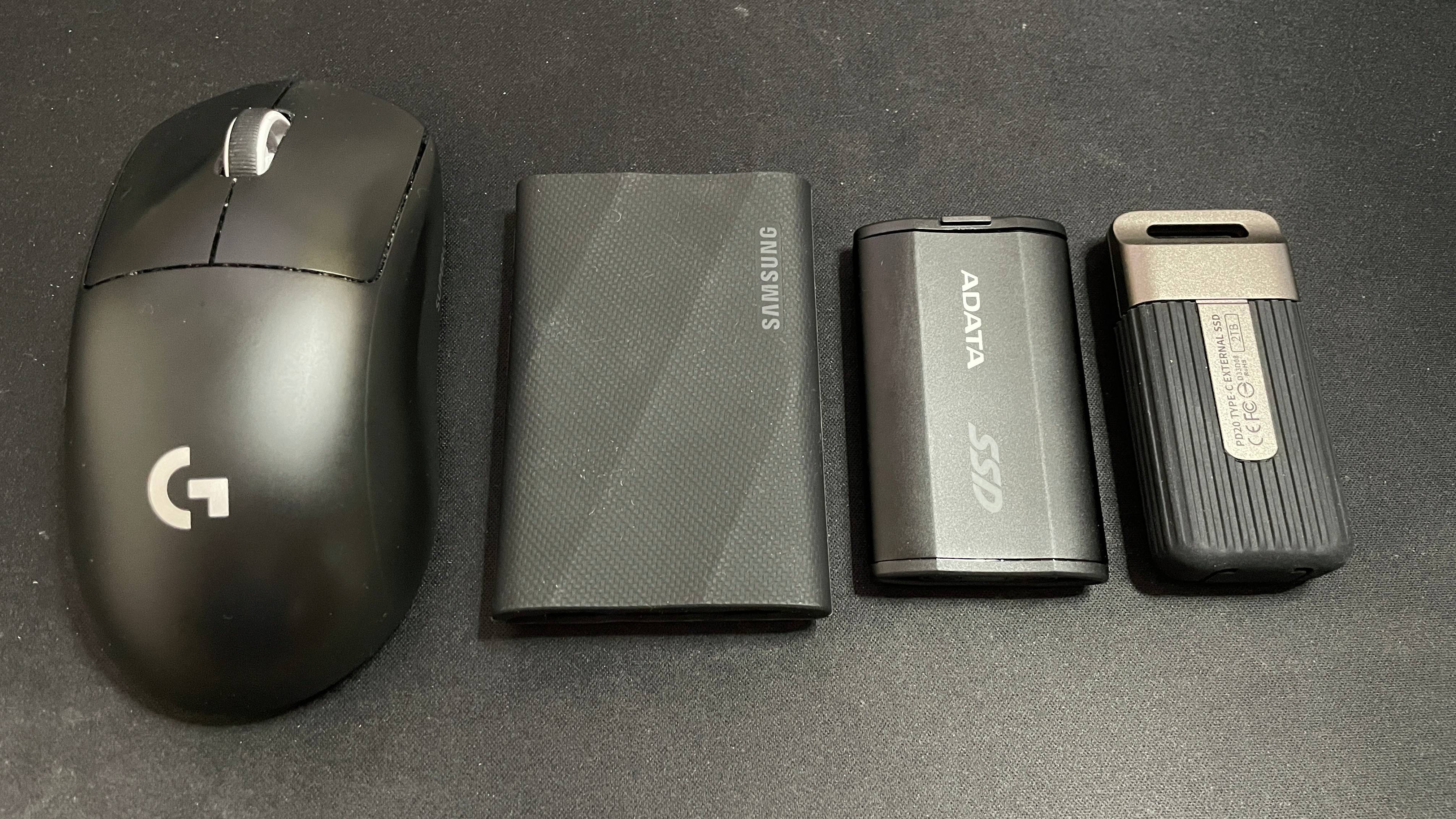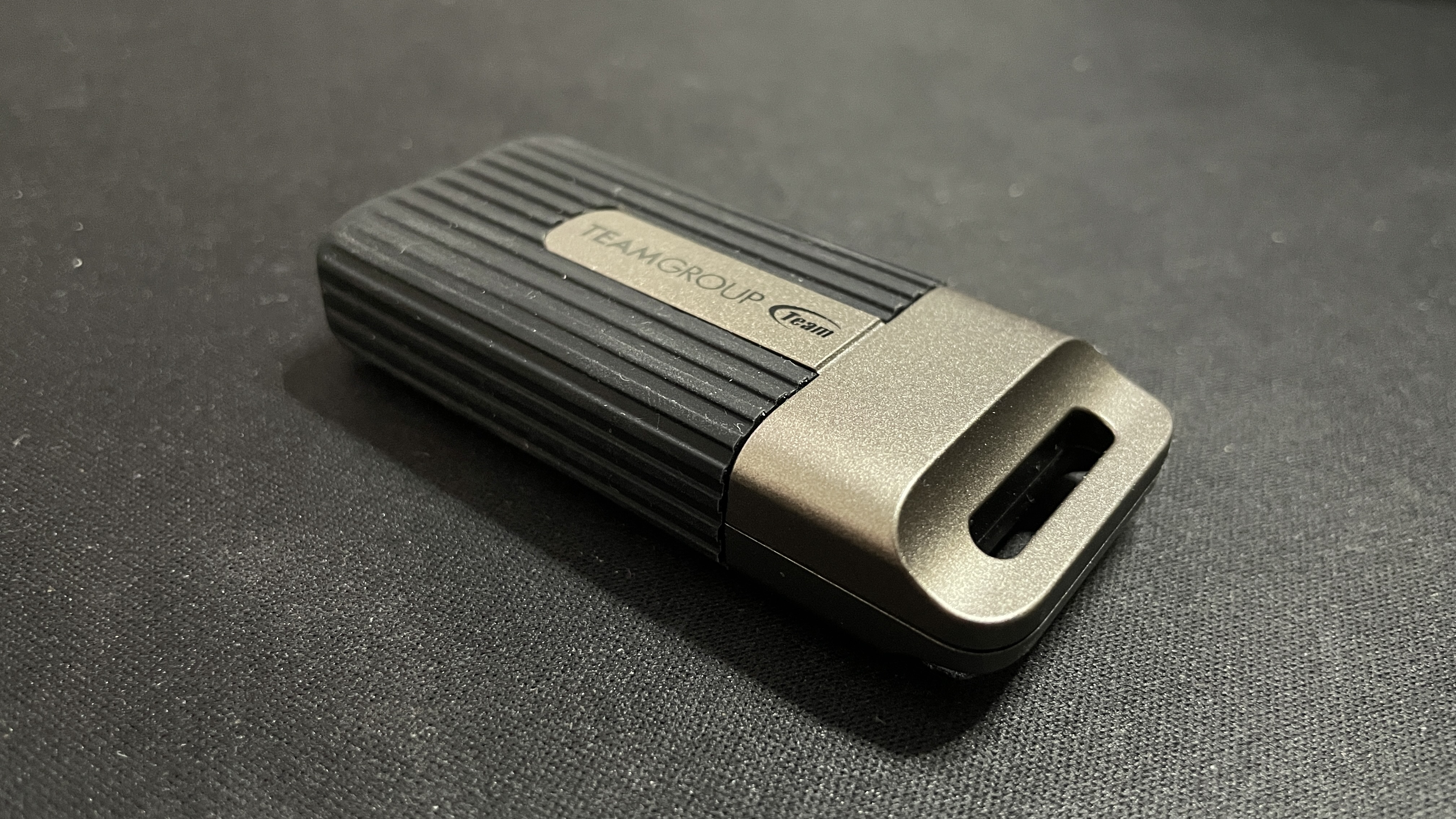Our Verdict
The TeamGroup PD20 can't maintain its peak sequential transfer speeds for as long as some similar drives, but this is a worthy sacrifice for its genuine portability. It's a solid, good-looking, dinky little thing that looks the part on a keychain.
For
- Really small and genuinely portable
- Looks and feels great
- IP54 dust and water resistance
- Has a hoop for a keychain
Against
- Only about 50 GB-worth of peak sequential transfer speeds
- Gets hot
- Dust cover is sometimes difficult to plug in
PC Gamer's got your back
It can be difficult to truly distinguish your external SSD from others in the same USB generation. USB 3.2 Gen 2x2 drives like this TeamGroup PD20, for instance, tend to share the same rated speeds, the same capacity options, and heck, even the same internals such as the controller.
TeamGroup's tackled this problem by putting its eggs into the form factor basket and going for a small but stylish portable SSD with the PD20. It's a strategy that has, in my opinion, paid off.
This isn't to say it's perfect—the PD20 has its problems, and we'll get into those shortly—but it really nails its strategy and delivers a very portable drive. Which, I need not remind us all, is what external SSDs are supposed to be all about: portability.
First off—and most obviously—it's incredibly small. For reference, check the gallery below and you'll see it next to the already very dinky Adata SD810, the Samsung T9, and then the Logitech G Pro X Superlight gaming mouse. But its size isn't all that makes it very portable.
You'll also notice a little hoop on top, which I can only assume is to attach it to something like a keyring. And this really shows how far we've come, doesn't it? This thing is so small and portable that it's practically the same as a USB flash drive but much faster and more capacious.
It's the kind of drive you can be proud to take out and about, too. It looks plenty fancy and the bulk of its ridged, rubberised shell is pleasant to hold and chuck around. Not that you should be doing lots of chucking around, mind, because this thing isn't the most durable drive ever. Mine survived a desk-height drop to the floor without any issues, though, and it feels durable enough to attach to your keys and plonk them hither and thither, as one tends to do with keys.
Don't worry about dust or water, either, because the PD20's body has a little rubber cover attached that pops into the USB-C port, preventing most everyday dust or liquid accidents from causing too much of a problem. Just make sure you double-check it's plugged, though, because I found that sometimes it wouldn't push in easily and I had to readjust the angle of the cover as I closed it to get that dust-tight grip.
Provided you've plugged the port properly, you should be protected up to the standard of its IP54 rating. That means it's dust-protected (though not dust-tight) and also resistant to "splashing water", which covers most potential hazards for a keychain SSD.





What do you get when you put all these things together? A very practical and stylish little drive that's also rated for speeds that are about as high as most modern PCs can handle over a USB connection (2,000 MB/s).
Rated speeds aren't real-life ones, though, and that's where things aren't quite so rosy for the TeamGroup PD20. But we wouldn't expect them to be, for such a small drive, would we? Smaller drives can't offer as much in the way of cooling and are therefore more likely to start throttling speeds quicker than others.
That turns out to be the case with the PD20, as far as I can tell. It does offer peak sequential transfer speeds similar to other USB 3.2 Gen 2x2 drives—just shy of 1,800 MB/s, in this case—but only for (almost exactly) 30 seconds, whereas other 3.2 Gen 2x2 drives such as the stellar Adata SD810 last over 2 minutes.
This amounts to just 49 GB of sequential data transferred before speeds slowed down drastically for the PD20, while the SD810 managed about 260 GB. Admittedly, other 3.2 Gen 2x2 drives sit between the performance of these two, but the PD20 was the worst of the bunch.
The reason for this, I can only assume, is that it's also the hottest of the bunch. It didn't take long at all for the PD20 to get toasty, and when it did it reached up to 83 °C. The other drives I tested maxed out well below this, at 65 °C or lower. This would naturally make for a drive that throttles itself quicker, before it's even ran out of its pseudo-SLC cache—which seems to be after about 3 minutes, or, put another way, after 150 GB of sequential transfer.
But does this really matter? I suppose that's down to each individual's use case, but speaking for myself, I can't imagine needing to transfer over 50 GB of data at a time all too often. That is, unless I was transferring a whole load of large game installs at once. If that's your use case then a dinky drive like this one might not be for you.
✅ You want a truly portable SSD: This thing is essentially a USB flash drive, but much faster. It even has a loop for a keychain!
❌ You want to do large file transfers: While the PD20 can crack out about 50 GB-worth of file transfers in one go while maintaining peak speeds, after this speeds quickly drop.
Speaking of gaming, this thing performs reasonably well, but it's far from the best USB 3.2 Gen 2x2 drive for gaming in terms of random 4k performance (as shown in the CrystalDiskMark results) and real-world gaming performance (as shown in the 3DMark Storage and FFXIV results).
Realistically, though, it performs well enough as a gaming drive that I don't think anyone would notice the difference. I transferred my sub-2 GB Crab Champions Steam install over to the drive, which took just a few seconds, and gave it a bash. The game played smoothly—no hitches—and new levels loaded instantly.
If you want the most consistently fast drive on the market, this one isn't for you. But if you want something small and genuinely portable, the PD20 mini external SSD is probably the best option on the market. Provided you have a USB 3.2 Gen 2x2 port, of course. If you don't, you'd be better off getting something like the Crucial X6 and calling it a day.
If you do have such a USB port, however, and as most modern-day PCs do, the PD20 is a cracking little drive that delivers exactly what it should given what it's going for. It is mini, and it feels and looks good to carry around. Just 50 GB-worth of peak performance at a time isn't anything to write home about, but if it's sheer portability you're after, and perfectly usable speeds, the PD20 has a lot to offer.
The TeamGroup PD20 can't maintain its peak sequential transfer speeds for as long as some similar drives, but this is a worthy sacrifice for its genuine portability. It's a solid, good-looking, dinky little thing that looks the part on a keychain.

Jacob got his hands on a gaming PC for the first time when he was about 12 years old. He swiftly realised the local PC repair store had ripped him off with his build and vowed never to let another soul build his rig again. With this vow, Jacob the hardware junkie was born. Since then, Jacob's led a double-life as part-hardware geek, part-philosophy nerd, first working as a Hardware Writer for PCGamesN in 2020, then working towards a PhD in Philosophy for a few years (result pending a patiently awaited viva exam) while freelancing on the side for sites such as TechRadar, Pocket-lint, and yours truly, PC Gamer. Eventually, he gave up the ruthless mercenary life to join the world's #1 PC Gaming site full-time. It's definitely not an ego thing, he assures us.

